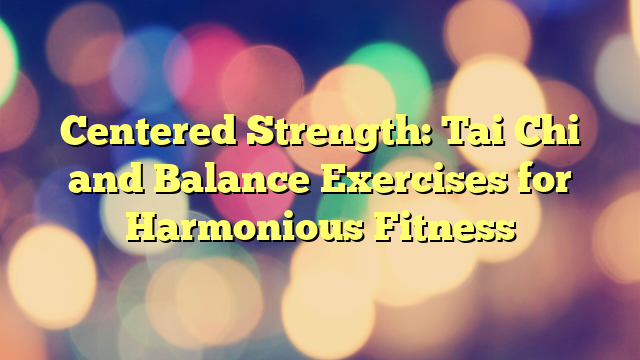Fluid Force: Tai Chi and Balance Exercises for Strength and Suppleness

Balance exercises play a crucial role in promoting strength, stability, and suppleness in the body. By enhancing our ability to maintain equilibrium, these exercises help improve our overall physical performance and reduce the risk of injuries. In this article, we will explore a variety of balance exercises that can effectively enhance fluid force within the body. So, let’s dive in and discover the transformative power of balance training!
Why Balance Exercises Matter
Before delving into the specific balance exercises, it’s important to understand why they are so essential for our overall well-being. By engaging in regular balance training, we can:
- Improve stability: Balance exercises help to strengthen the muscles that support our joints, enhancing stability and reducing the risk of falls. They focus on the core muscles, legs, and ankles, which are all essential for maintaining balance and stability.
- Strengthening the muscles in our legs and core can provide a solid foundation for better stability. This is especially important for older adults or individuals with balance issues.
- Improved stability not only helps prevent falls but also enhances our performance in various physical activities, such as sports or even everyday tasks like walking or climbing stairs.
- Enhance proprioception: Proprioception refers to our body’s awareness of its position in space. By practicing balance exercises, we can improve this crucial sense, leading to better coordination and control. Proprioception plays a vital role in our ability to move efficiently and maintain balance.
- Balance exercises challenge our proprioceptive abilities by requiring us to make subtle adjustments in our body position to maintain equilibrium. This helps train the body to respond quickly and accurately to changes in balance.
- Better proprioception can also contribute to improved athletic performance, as it allows athletes to react more effectively to their surroundings and make precise movements.
- Build core strength: Many balance exercises require engagement of the core muscles, leading to improved core strength and stability. The core muscles include the abdominal muscles, lower back muscles, and the muscles around the pelvis. Strengthening these muscles is essential for maintaining good posture, stability, and overall body strength.
- Core strength is crucial for maintaining balance and stability during various activities, such as walking, running, or lifting weights. It helps transfer force between the upper and lower body effectively, preventing strain on other muscles and joints.
- A strong core also supports the spine, reducing the risk of back pain and improving overall posture. It contributes to a more efficient and stable movement pattern, enhancing athletic performance and reducing the risk of injuries.
- Promote joint health: Balance exercises can help to increase joint mobility and reduce the risk of joint-related issues over time. By challenging our balance, we encourage the joints to move through a full range of motion, promoting joint health and preventing stiffness or tightness.
- Balance exercises that involve single-leg movements, such as the single-leg stance or yoga tree pose, help improve joint stability and mobility. These exercises require the joints to work independently, which can help prevent imbalances or weaknesses.
- Enhanced joint health not only improves our overall physical performance but also reduces the risk of arthritis, joint pain, and other age-related joint issues.
- Enhance athletic performance: Whether you’re an athlete or simply enjoy physical activities, balance exercises can contribute to improved performance by enhancing body control and coordination. They challenge our ability to maintain balance in dynamic and unpredictable situations, mimicking the demands of sports and other physical activities.
- Improved balance and coordination can enhance agility, quickness, and reaction time, allowing athletes to perform at their best. It helps with changing direction, maintaining stability during explosive movements, and controlling body movements with precision.
- Even non-athletes can benefit from enhanced body control and coordination. It can improve performance in activities like dancing, hiking, or even everyday tasks that require balance and coordination.
1. Single-Leg Stance
The single-leg stance is a fundamental balance exercise that focuses on developing stability and strength in the lower body. It primarily targets the muscles in the legs, including the quadriceps, hamstrings, calves, and glutes.
- Begin by standing up straight with your feet hip-width apart.
- Shift your weight onto one leg, slightly bending the knee of the supporting leg.
- Lift the other leg off the ground and hold the position for 30 seconds.
- Repeat on the other leg.
- As you progress, try extending the duration of the hold or closing your eyes to further challenge your balance.
- To maximize the benefits of the single-leg stance, focus on maintaining proper form throughout the exercise. Keep your standing leg slightly bent and engage your core muscles to stabilize your body.
- For added difficulty, you can perform variations of the single-leg stance, such as reaching forward or sideways with your arms while maintaining balance. This challenges your stability and coordination further.
- Incorporate the single-leg stance into your warm-up routine or as a standalone exercise. Aim for 2-3 sets of 30 seconds per leg, gradually increasing the duration as your balance improves.
2. Yoga Tree Pose
The Tree Pose is a classic yoga posture that not only improves balance but also helps to open up the hips and stretch the legs. It primarily targets the muscles in the legs, hips, and core.
Instructions:
- Start by standing tall with your feet together.
- Shift your weight onto your left foot and place the sole of your right foot on the inner left thigh, just above or below the knee.
- Bring your hands together in front of your chest in a prayer position.
- Find a focal point in front of you to help maintain balance.
- Hold the pose for 30 seconds to 1 minute and then switch sides.
- For an added challenge, try closing your eyes or raising your arms overhead while in the Tree Pose.
- The Tree Pose requires focus, concentration, and steady breathing. It challenges your balance and tests your ability to maintain a stable position while performing static balancing.
- As you become more comfortable with the Tree Pose, you can explore variations, such as extending your arms out to the sides or reaching them overhead. These variations engage the core muscles and further enhance your balance and stability.
- Practice the Tree Pose regularly to improve your balance and flexibility. Aim for 2-3 sets of 30 seconds to 1 minute per leg, gradually increasing the duration as you progress.
3. Bosu Ball Squats
The Bosu Ball Squats are a dynamic balance exercise that not only works the lower body muscles but also challenges your stability and core strength. It primarily targets the muscles in the quadriceps, hamstrings, glutes, and core.
Instructions:
- Stand on a Bosu Ball with the flat side down, positioning your feet shoulder-width apart.
- With your arms extended in front of you, begin to squat down by bending your knees and pushing your hips back.
- Maintain your balance as you lower yourself into a squat position, aiming to keep your knees aligned with your toes.
- Slowly return to the starting position and repeat for 10-15 repetitions.
- As you become more comfortable with the exercise, you can progress by holding weights or performing single-leg squats on the Bosu Ball.
- The Bosu Ball Squats challenge your balance and stability by creating an unstable surface. This engages the core muscles and forces them to work harder to maintain proper form throughout the exercise.
- To ensure proper alignment, focus on keeping your knees in line with your toes and your back straight as you squat. Engage your core muscles to stabilize your body and prevent excessive leaning or tilting.
- Start with bodyweight squats on the Bosu Ball and gradually increase the difficulty by adding weights or performing single-leg squats. Aim for 2-3 sets of 10-15 repetitions, gradually increasing the number of repetitions as you progress.
4. Heel-to-Toe Walk
The heel-to-toe walk is a simple yet effective exercise that helps improve balance and coordination while targeting the muscles in the legs and core.
Instructions:
- Find a straight line or use a piece of tape to create a line on the ground.
- Stand with your feet touching and your arms extended to the sides for better balance.
- Focus your gaze ahead and start walking forward, placing your right heel directly in front of your left toes.
- Continue walking in a straight line, ensuring that the heel of one foot touches the toes of the other foot with each step.
- Aim to take at least 20 steps before turning around and walking back.
- To increase the difficulty, attempt the heel-to-toe walk with your eyes closed or while carrying light weights.
- The heel-to-toe walk challenges your balance and coordination by requiring precise movements and control over your body position. It helps improve the strength and stability of the muscles in your legs and core.
- Maintain a steady pace and focus on placing one foot directly in front of the other, ensuring that your heel touches the toes of the opposite foot with each step. Engage your core muscles to stabilize your body and prevent excessive leaning or wobbling.
- Start with a shorter distance and gradually increase the number of steps as you become more comfortable. You can also add variations, such as walking backward or sideways, to further challenge your balance and coordination.
5. Stability Ball Planks
Stability Ball Planks are a fantastic way to challenge your core stability while improving overall balance and strength. They primarily target the muscles in the core, including the abdominal muscles, lower back muscles, and shoulders.
Instructions:
- Start by placing your forearms on a stability ball, ensuring that your elbows are directly under your shoulders.
- Extend your legs behind you, balancing on your toes, while keeping your body in a straight line.
- Engage your core muscles and hold the plank position for 30 seconds to 1 minute.
- As you progress, increase the duration of the hold or try lifting one leg off the stability ball for an added challenge.
- The Stability Ball Plank challenges your core stability by creating an unstable surface. This engages the deep core muscles and forces them to work harder to maintain proper form throughout the exercise.
- To maintain a proper plank position, focus on keeping your body in a straight line from your head to your heels. Avoid sagging or lifting your hips too high. Engage your core muscles and squeeze your glutes to stabilize your body.
- Start with a shorter duration and gradually increase the hold time as your core strength improves. You can also add variations, such as lifting one leg off the stability ball or performing side planks, to further challenge your core stability.
Conclusion
Balance exercises are a valuable addition to any fitness routine. By incorporating these exercises into your regular workouts, you can enhance your overall stability, strength, and suppleness. Whether you’re a professional athlete or someone looking to improve their daily life activities, balance exercises offer numerous benefits. So, start incorporating these fluid force-enhancing exercises into your routine and experience the transformative effects they have on your body and mind!

